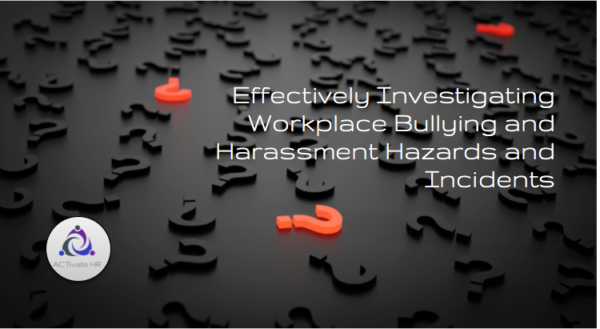It’s happened. A psychological hazard has been identified, despite your best preventative efforts. Or worse, you’ve received a bullying or harassment claim. Having a solid plan in place for bullying and harassment investigations is critical to your success in addressing the complaint.
Developing a process for bullying and harassment investigations
In this article, we address key considerations for developing bullying and harassment investigations processes to address hazards, violence, and injuries that are psychological in nature.
Hint: Your psychological violence and injury investigation process will be different than how you address physical hazards and injuries.
Must-dos
While your investigation process will not be exactly the same as the one you use to investigate physical hazards and injuries, there are many similarities:
- Once an incident of any nature is reported it must be investigated quickly. Check out this great resource on five must-do’s when a complaint comes in.
- Besides actual incidents that occur and will be investigated, any identified potential hazards must also be investigated.
- As with physical injuries and incidents, claims cannot be ignored and a qualified individual should be assigned to investigate.
- The goal of the investigation should include not only identifying what happened but also the underlying causes and remedial actions to prevent future occurrences.
- Investigators should not be biased or have any personal investment in the outcome or recommendations.
- If one or more of the parties involved in the incident left the organization, the situation should still be investigated.
- The investigation process should be clearly defined so that all employees understand who will be involved, what the steps will be and realistic timelines.
- You should have internal guidelines about when external investigators are brought in.
Important considerations
When creating the investigation policy and process associated with psychological hazards and injuries, some considerations are:
- There will likely be confidentiality and privacy issues that are not present with physical safety investigations.
- You may need to remove one or more parties from the situation or workplace in a non-punitive way until the investigation is complete.
- Your policies should have clear rules and definitions about confidentiality and protection from, and consequences of, retaliation for reporting incidents or participating in investigations. All individuals participating should have these clauses given to them or read to them at the beginning of the investigation interview.
- Investigating bullying, harassment and sexual harassment is like, but not the same as, investigating a physical injury. What’s needed is a different investigative skill set. The company needs to ensure investigators have the specific skills and experience to investigate these types of incidents. Individuals with these skill sets are often housed within the HR department. Even companies with internal, trained investigators will want to bring in external investigators in some cases. For example, when senior leaders are involved or if there is a real or perceived bias on the part of the investigator. You can find information on determining if your internal investigators are equipped to handle these investigations here.
- Have a plan in place for involving legal counsel. This decision will involve similar criteria to that related to bringing in external investigators.
- The investigation process should include the development and implementation of corrective actions. It should also entail how to track the effectiveness of the corrective actions. This will often call for tracking mechanisms that measure changes in culture. Ways of doing this include engagement surveys, stay / exit interviews, and culture assessments.
External investigations
Serious breaches of policy or investigations at senior levels of the organization are a couple of times when you are more likely to require an external investigator.
Factors to consider when determining whether to hire an external investigator include:
- Whether there are people in-house who have skills and experience investigating bullying, harassment, sexual harassment and other forms of psychological harm.
- If a senior-level leader is named in the complaint: When the most senior levels of an organization are involved, an external investigation is advised. This is due to the inherent power imbalance of an internal investigator and a senior leader – even if they are in differing departments.
- Is there real or perceived bias due to the relationship between the investigator and those involved? This should include if the respondent has any real or perceived impact on the assessment or career of the investigator. It should also include the history and relationship between the investigator and those involved in the complaint.
- The seriousness of the claim: Is a human rights complaint anticipated? Or are there potentially serious consequences, such as termination or demotion? Then an external investigator is recommended.
More help with effective bullying & harassment investigations
More advice on dealing with sexual harassment complaints can be found in this post. For tips on preventing good investigations from turning bad, click here.
We hope you found this, our sixth article in our eight-part series on being compliant with Bill 30 and creating a psychologically safe workplace, helpful. Want to read the series from the beginning? Click here. To go to the previous article on assessing and reporting psychological workplace hazards and incidents, click here. To see the next article in the series, click here.
Activate HR has many years of experience with helping organizations create respectful workplace policies, programs, and cultures. We also assist with investigating workplace incidents such as bullying, harassment, and sexual harassment. Contact us today at info@activatehr.ca. We can help with your bullying and harassment investigations policy, leader and employee training, and investigation needs.
Enjoyed this article? Here are three more to help you:
Pointing Out Mistakes and Other Surprising Habits From Leaders of the Most Profitable Companies
The Worst Has Happened. Now What?
Effectively Investigating Workplace Bullying and Harassment Hazards and Incidents
This article was originally published on June 19, 2018. It has been updated.

